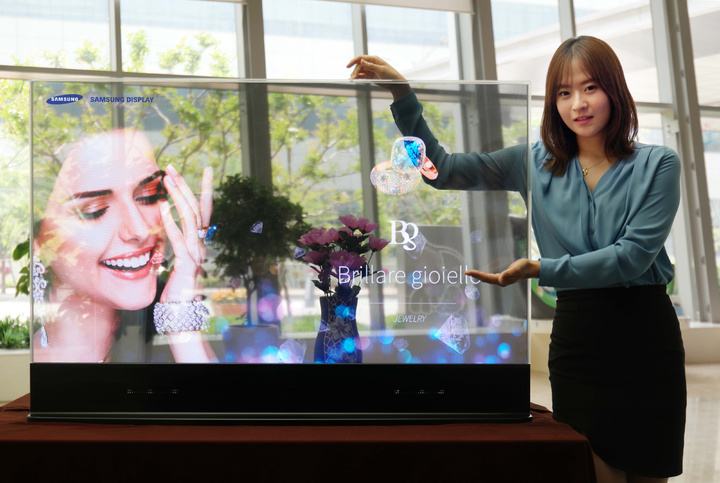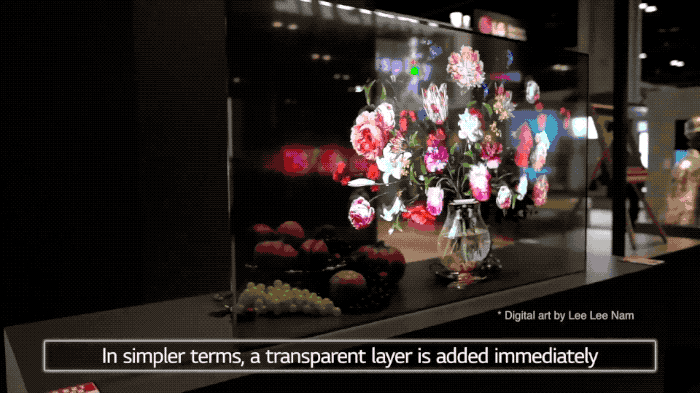The sci-fi sense of LCD screens transparent is unforgettable for many people. And there may be flexible transparent electronic wearable devices in the future. How are these magical effects achieved? Let’s take a look.
The LCD transparent display is mainly divided into two parts, the panel and the backlight panel. The screen forming part is mainly divided into a pixel layer, a liquid crystal layer, and an electrode layer (abbreviated as TFT).
Regarding the principle of transparent LCD screen, we must talk about the principle of screen formation. The logic board sends the image signal from the signal board, and after the logic operation is performed, the output controls the TFT switch, that is, the flipping action of the liquid crystal molecules, which is used to control whether the light source can pass through, showing the corresponding pixels, and forming a color that allows people to see screen.

“Principle and composition of transparent liquid crystal display”
The LCD screen is a display device based on the liquid crystal electro-optic effect. It includes character segment display device in segment display mode; character, graphic and image display device in matrix display mode; large-screen LCD projection TV LCD screen in matrix display mode, etc. The liquid crystal screen uses the physical properties of liquid crystal molecules to change the distribution of liquid crystal molecules under the influence of current and voltage, thereby changing the strength of the light source.
Technically speaking, the LCD panel consists of two pieces of sodium-free glass material with a layer of liquid crystal sandwiched in between. Liquid crystal substances are composed of long rod-shaped molecules and belong to organic complexes. In the natural state, the long axes of these liquid crystal molecules are approximately parallel. The liquid crystal is poured into a slotted plane, and the liquid crystal molecules are distributed in parallel in the slot. When light passes through, the liquid crystals will take on different shapes, thus blocking or transmitting light.
Transparent displays using LCD displays are all layered structures composed of different parts. The LCD consists of two glass plates, about 1 mm thick, separated by a uniform interval of 5 μm containing the liquid crystal material. Because the liquid crystal material itself does not emit light, there are lamps on both sides of the display screen as light sources, and there is a backlight plate (or uniform light plate) and a reflective film on the back of the liquid crystal display screen to provide a uniform backlight source.

When illuminated by the light source, the light is first transmitted upward through the lower polarizer, and is conducted by liquid crystal molecules. Since the electrodes of the upper and lower interlayers are changed to FET electrodes and common electrodes, when the FET electrodes are turned on, the arrangement state of the liquid crystal molecules will change, and the purpose of display is achieved by shading and transmitting light.
But the difference is that, due to the capacitive effect of the FET transistor, it can maintain the potential state, and the liquid crystal molecules that had previously transmitted light will remain in this state until the FET electrode is recharged next time to change its arrangement.
At present, most transparent liquid crystal screens use backlight to pass through the liquid crystal panel. Under the action of the electric field, the arrangement of liquid crystal molecules changes, which affects the change of light passing through it. , so as to achieve the purpose of displaying the image.
We know the light transmission principle of the transparent LCD screen. Since the liquid crystal material itself does not emit light, it is necessary to provide a light source. Therefore, there are light sources on both sides of the display screen. The plate is composed of fluorescent substances, which can emit light, and its main function is to provide a uniform background light source.
Many times, we often confuse LCD transparent display and LED transparent display. In fact, the two are still very different.
The LCD transparent display is often clearer than the LED transparent display. However, LCD has always had two fatal shortcomings, that is, it cannot be unlimited splicing and seamless splicing. Because of the special light-emitting form of LCD, it needs a frame to wrap it. Therefore, regardless of the thin LCD screen, it is inevitable that there will be a frame of a few tenths of a millimeter.
As the area of splicing increases, the impact of the frame is also greater. From this point of view, LCD display or LCD transparent display is suitable for small and exquisite products. In the field of infinite splicing, LCD is also Powerless.
LED transparent screens are mainly used in conditions that do not require close viewing, such as outdoors or indoor large-area partition walls, which is also due to its low pixels. The principle of transparency should be understood by those who have seen the blinds. It is to widen the distance between the pixels and leave a gap so that you can see the back. As for how to leave a gap and how to fix it, each has its own method. .
A simple summary of the application scenarios and constraints of LED transparent screens is that the pixel requirements are not high, and it is definitely the right choice for outdoor use. Some customers have been curious before, why not just make the LCD bigger, even if there is a small amount of borders, it doesn’t matter, can’t it be bigger?

In fact, this has a lot to do with the technology and transportation of the LCD screen. In addition to the different display technologies just mentioned, there are also big problems in the transportation of the oversized LCD screen.
Because the LED display is spliced with a single box and a single box, and the LCD display to achieve the corresponding display effect, either endure the black edge of each splicing part, or make the screen larger.
No matter which one it is, it greatly restricts the LCD. After all, if the volume becomes larger, the volume and weight during transportation will cause the freight to rise sharply, and it will also require a lot of manpower and material resources during installation and use.
Taken together, LCD and LED are originally in different directions. One is a world of infinite possibilities, and the other is a small and beautiful world. Both have their own areas of expertise. There is no need to force yourself into unnecessary places.
And if a commodity occupies all the dominant positions and forms a monopoly, then the price is determined by the manufacturer, and if you want to increase the price, you can increase the price. Even if you are not satisfied, there is nothing you can do. This is the case with our common gasoline, if there is no electric car , if you can’t afford to buy gasoline, then you can’t drive.